‘This Is Their 1776’: US Army Veterans Train Ukraine Civilians in Resistance Warfare
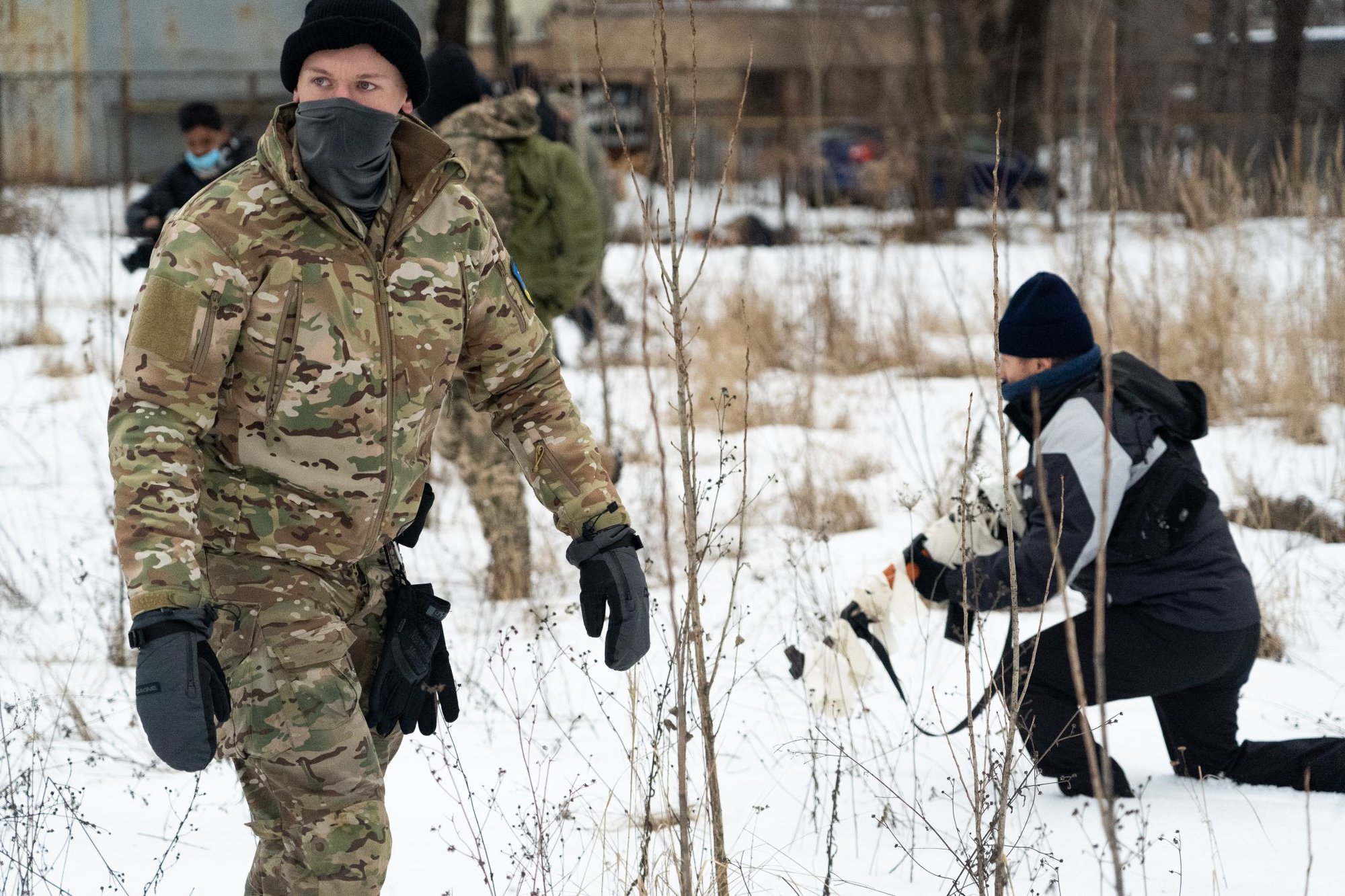
US Army veteran Adam leads a military training course with the Georgian National Legion in Kyiv on Tuesday, Feb. 8, 2022. Photo by Nolan Peterson/Coffee or Die Magazine.
KYIV, Ukraine — During his two tours in Afghanistan as an Army Ranger, Adam never wrote a death letter to his mother. After just two days in Ukraine, he’s finally ready to write that last farewell. Although he’s come to help train civilians in irregular warfare, Adam, who spent four years of his early adulthood fighting insurgents in Afghanistan, says he’s now ready to join a Ukrainian insurgency — should Russian forces attack the capital city of Kyiv.
“I’m just here because the Ukrainians are fighting for their independence and I think I can help that. I figured it would be a better use of my time on this earth to come help them,” says Adam, who asked that his last name not be used due to security concerns.
“This is their 1776,” he adds.
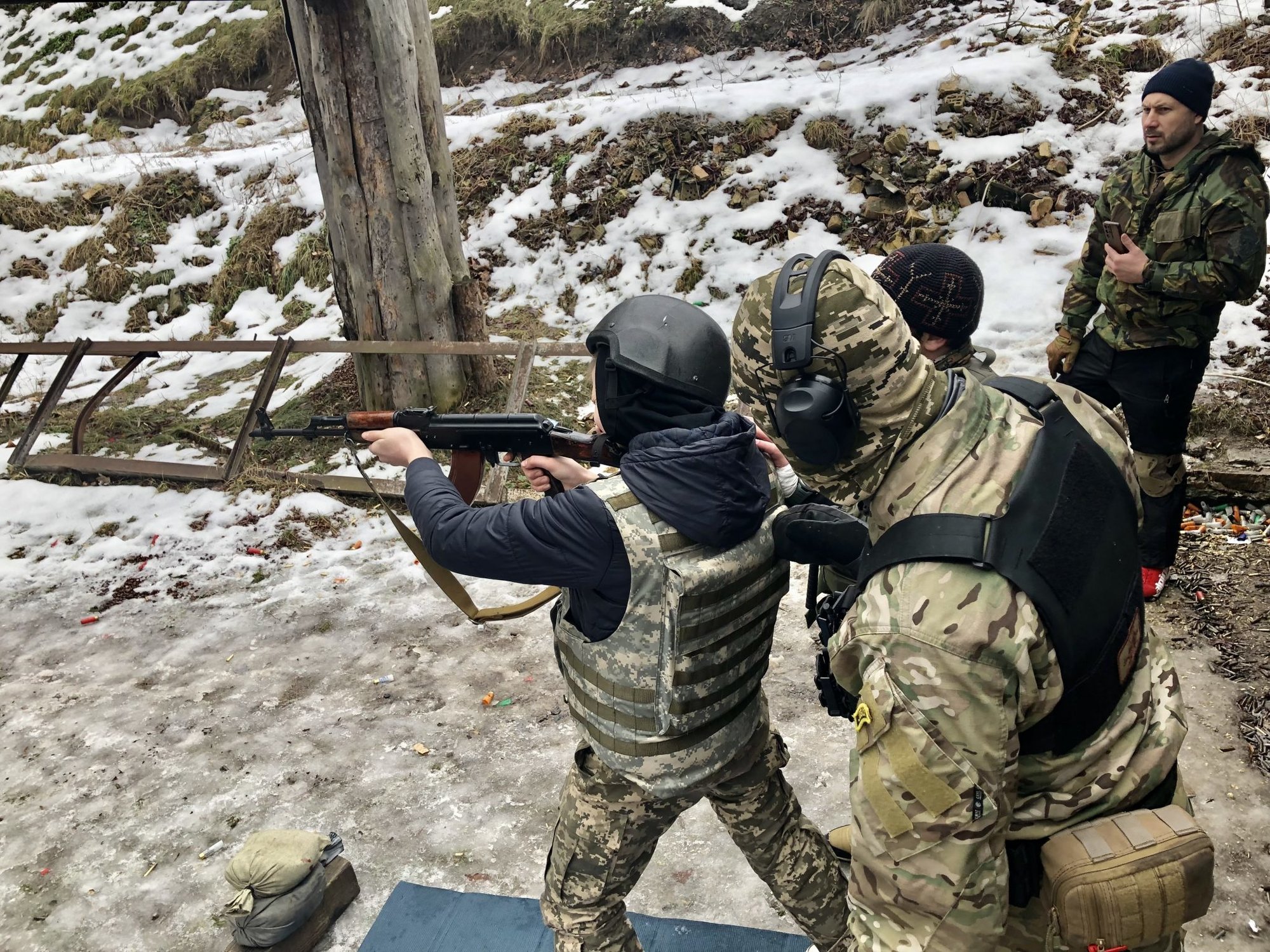
A 25-year-old former US Army corporal from South Carolina, Adam served in the 1st Ranger Battalion from 2015 to 2019. On this Tuesday night, Feb. 8, he’s enjoying pizza and beer at a downtown Kyiv restaurant. When he starts to explain what it was like to say goodbye to his mother a few days ago, he pauses, takes a swig of beer, and waits a moment. For a split second, the young man’s eyes reflect the light a little differently. Then he blinks his eyes clear and says, “My mom really didn’t want me to go. It was the hardest goodbye of my life.”
Earlier that afternoon, Adam led a group of Ukrainian civilians through a basic military training course. Among the trainees was a 13-year-old boy named Oleg. Hours later while at dinner, Adam stares into his beer and explains that the sight of Oleg training for war had laid bare the potential human tragedy of a Russian re-invasion of Ukraine.
“He just looked so young,” Adam says. “That kid should be out playing with his friends, not getting ready for a Russian invasion.”

Sitting across from Adam on this night is Paul, a US Army veteran of the 101st Airborne Division who served three tours in Iraq. Along with Adam, he also took part in the day’s civilian training exercise and is similarly prepared to take up arms and fight if Russian forces attack Kyiv. However, the looming threat of a major Russian offensive did not draw Paul to Ukraine. He’s already lived in the country for 15 months and come to see it as his adopted home. Thus, amid the growing threat of a major Russian attack, Paul (he similarly asked that his last name not be published for security reasons) sees it as his moral duty to do what he can to help his newfound neighbors and friends.
“I’m a male with military training and background and I have a moral responsibility to help defend these people. There are women, children, elderly. It would be ethically unacceptable if I were to just run away when the people here needed help,” says Paul, who was an air assault infantry sergeant in the 101st Airborne.
In 2020, Paul was living in Denver and had a steady career in corporate security. When the pandemic lockdowns began, however, he quit his job and began a meandering journey across Eastern Europe. He had no particular destination in mind, and no return ticket. Just a desire to get away. Paul briefly settled in Belarus but was abruptly expelled by government officials during the 2020 protests. After arriving in Ukraine on somewhat of a lark, he soon settled into a new life — he’s since opened a gym in Kyiv and calls the city his home.
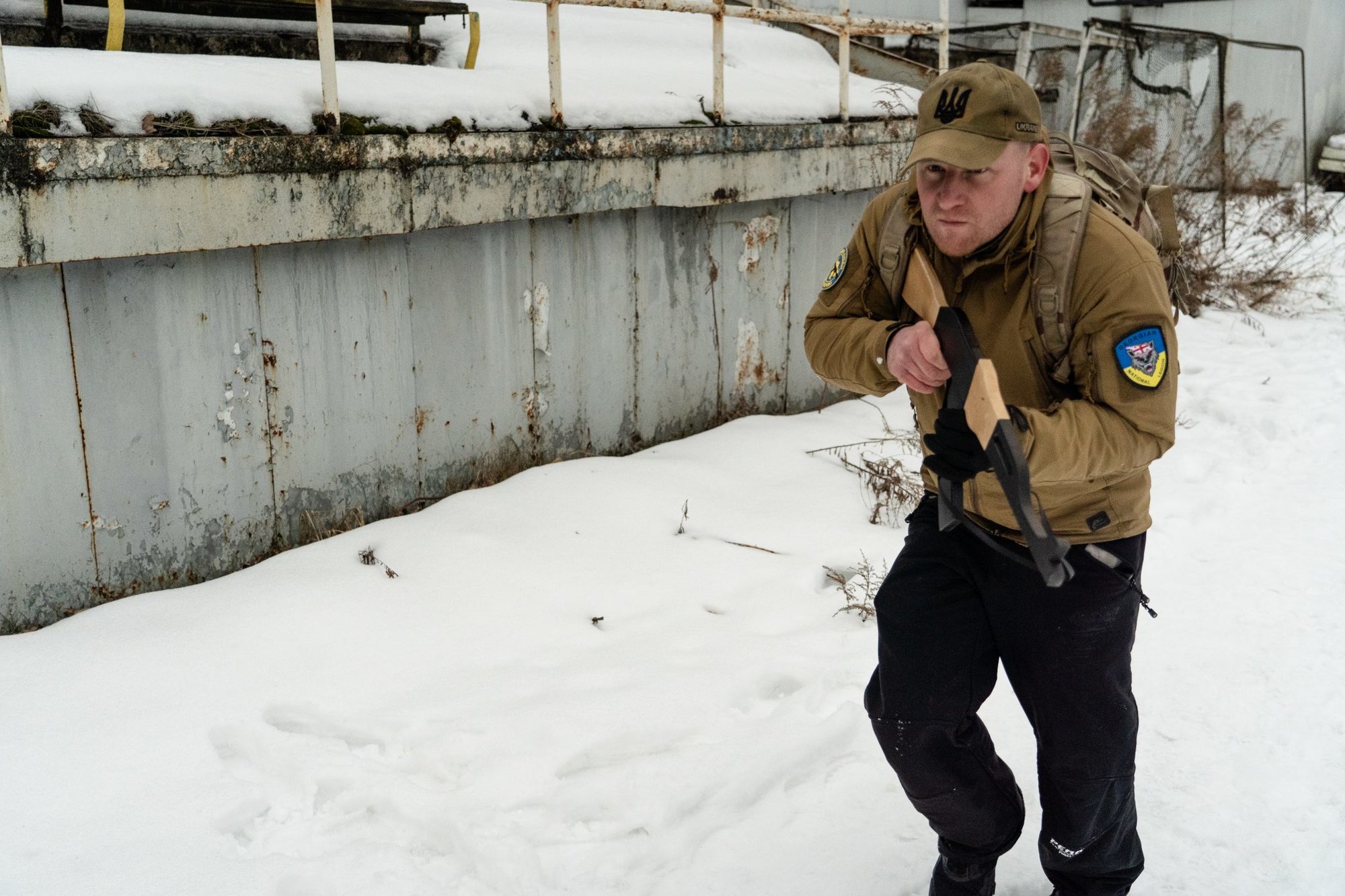
Paul, who enlisted in the Army in 2003, has been particularly moved by young Ukrainians who took part in the 2014 pro-Western Revolution of Dignity and then spearheaded a grassroots, volunteer war effort to defend their country against Russia’s invasion of the Donbas. In fact, Paul’s deep respect for Ukraine’s veterans led him to take volunteer action well before the current border confrontation caught the world’s attention. For a year he’s been teaching English at a popular veterans center, and this winter he completed a grueling winter ascent of Ukraine’s highest mountain, Hoverla, with a group of Ukrainian combat veterans.
“I’m impressed by how resolute the younger generation is here. I’ve met a lot of really outstanding young people who time and time again have stepped up to defend their country — not for their own self-interest, but for the nation at large,” Paul says. “Ukraine’s only been independent for 30 years, and this younger generation, they are the first independent generation, and I think that they see it as their generational duty to defend their young democracy.”
Russia’s military buildup spurred Paul to retune his combat skills — not only to help train civilians in basic military skills, but to make sure he’s prepared to help defend his adopted hometown should Russia attack.
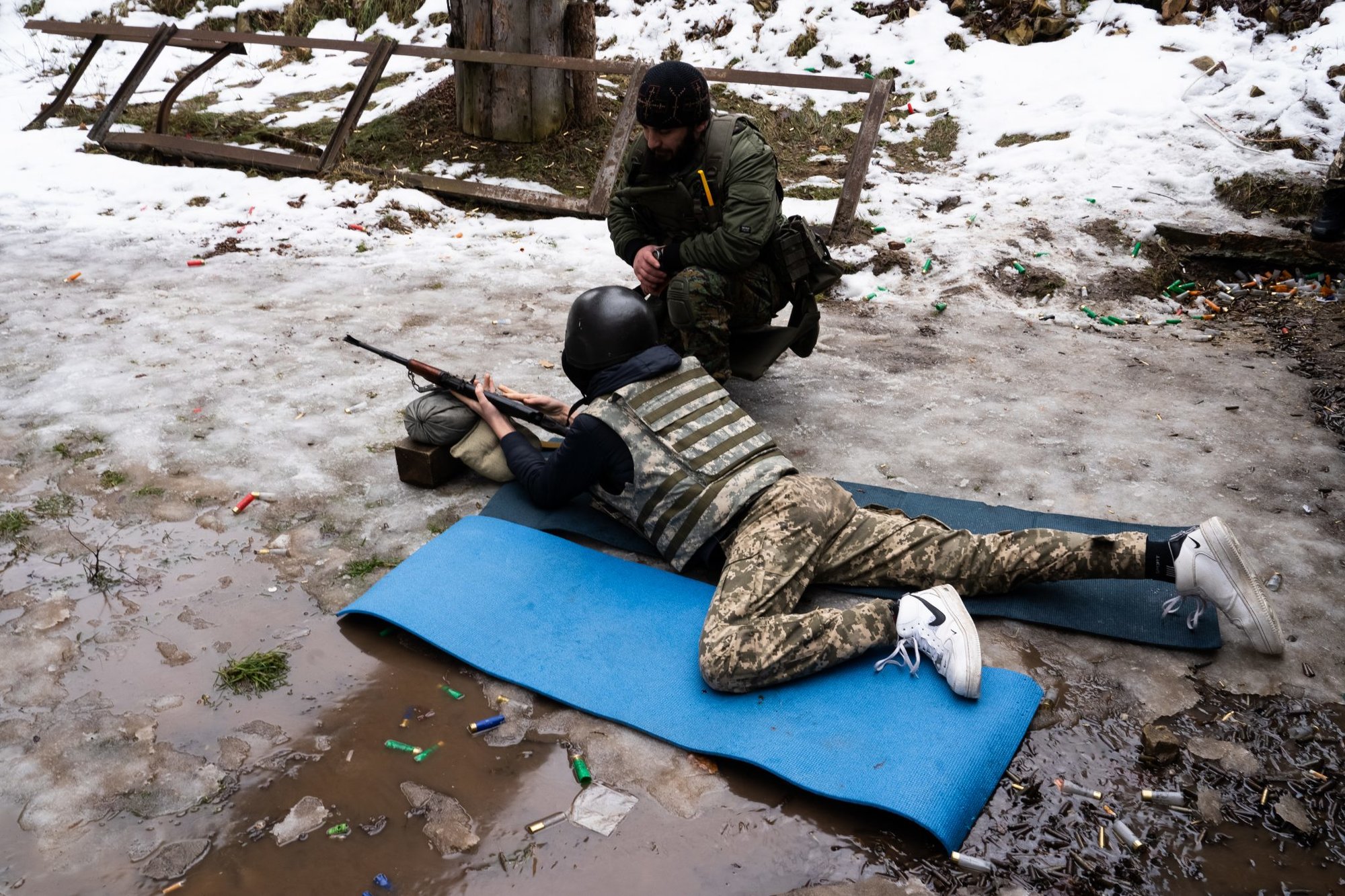
“I felt like I was a really good soldier in the American military. But after the tours in Iraq, I didn’t feel the motivation to want to take the field again,” Paul says. “But having this military threat come to my new adopted home, it gave me the motivation to want to stay in shape. I’ve been exercising really hard lately. I’ve been refreshing my tactical skill set, and mentally I’ve been getting myself in the mindset of getting ready to devote long periods of time away from my regular civilian lifestyle.”
When he was a US Army soldier, Paul would load onto a transport plane and travel halfway across the world to fight in a foreign land. Now, he’s experiencing war in an entirely new and alien way — from the perspective of civilians whose lives are about to be disrupted or destroyed by it.
“When I was young and in the 101st Airborne, going to Iraq was a great military adventure,” Paul says. “It was for glory and to prove myself as a professional soldier. This time I have nothing to prove; I’m just trying to help my neighbors and friends.”
As the weeks drag on and the situation in Ukraine grows increasingly more dire, it has become harder for Paul to easily enjoy ordinary life without also remembering what may happen here soon. Could all of this — all of the joy of ordinary, peaceful life — simply be a prologue to some great tragedy?
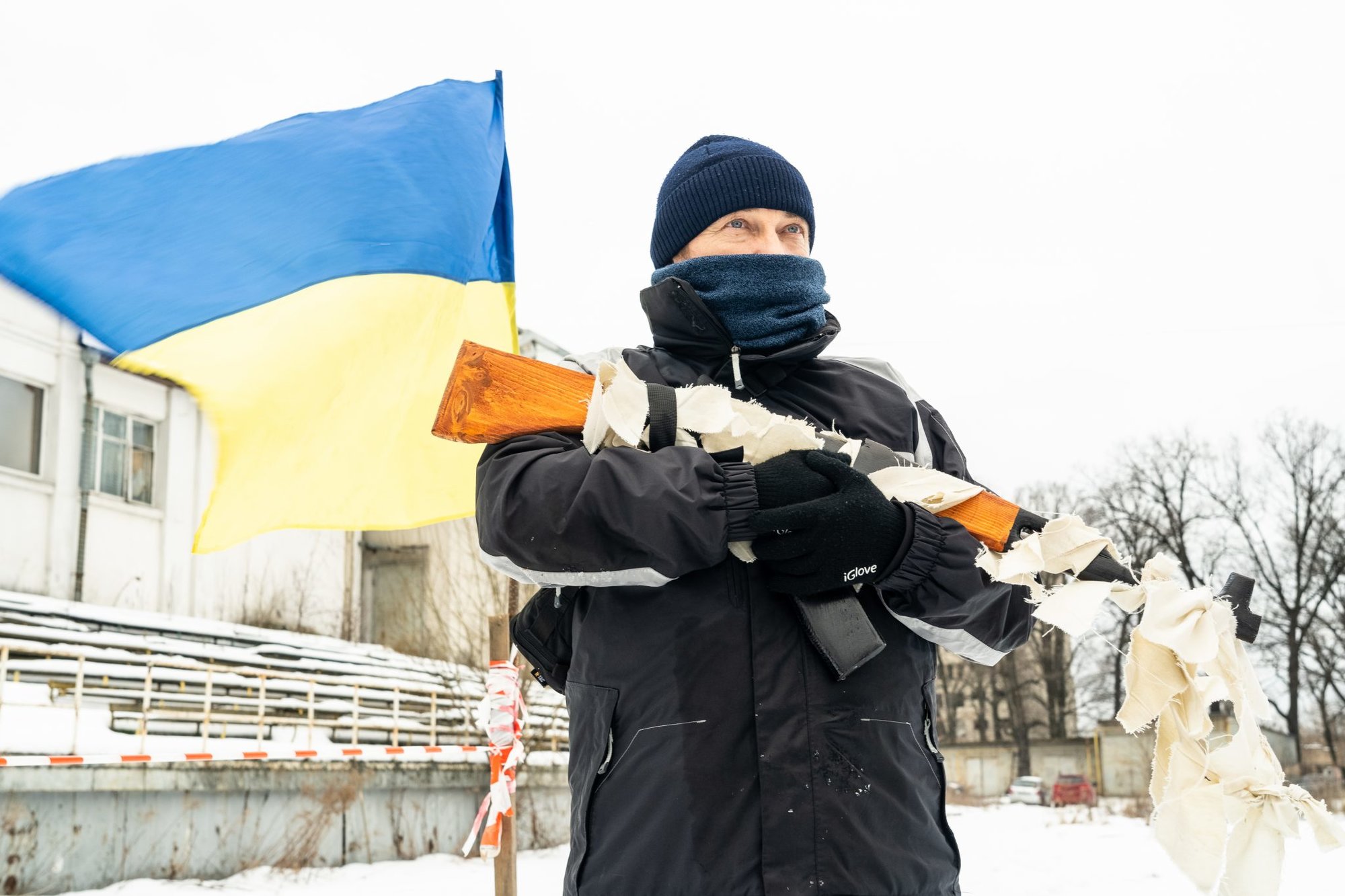
“I see these kids going to school with their little backpacks and Ukrainian flags. You see constantly, the patriotism, and you have all the people that you meet asking all these nervous questions about what they should do — and they’re asking me, like I should know what they need to do,” Paul says.
He adds: “When I went to war in Iraq, it was, you know, it was for my military unit, for my brothers in arms, for the guys I was training with. Here, it’s a much different motivation than an American being far from his home on some kind of grand operation. This time it’s a basic need to stand up and help defend my neighbors, my friends. My home. It’s surreal. It’s a feeling I don’t think many Americans have ever experienced.”
For his part, Adam is continuing online university classes in pursuit of a bachelor of arts degree with Charleston Southern University. Before coming to Ukraine, he had a lucrative job in the information technology sector. Like many combat veterans, however, Adam found civilian life “monotonous” and longed to rediscover the sense of purpose and tribal belonging he’d possessed while in the military. Yet, his decision to come to Ukraine stemmed from a much deeper, more foundational part of his personality than a simple incompatibility with civilian life. A devout Christian, Adam also considers it his moral duty to help Ukrainians defend themselves.

“Ukrainians are fighting for their democracy, and their identity outside of Russia,” Adam says. “They have a rich, independent history, and it’s worth fighting for.”
It’s a clear and cold Tuesday morning when Adam and Paul arrive at the Georgian National Legion’s base on the outskirts of Kyiv. Amid the mounting Russian threat, this unit of foreign volunteer soldiers has launched a new military training course for civilians. The drills have lasted about a week, and each day it’s particularly striking to observe dozens of everyday Ukrainians, ranging in age from 13 to 60, sprinting through the snow with training weapons clutched in their hands.
Under the command of a former Georgian military officer named Mamuka Mamulashvili, the Georgian National Legion formerly operated as a front-line unit in the early years of the war in Ukraine’s eastern Donbas region. Now garrisoned on the outskirts of Kyiv, this all-volunteer unit has become a clearinghouse for foreigners in the application pipeline to sign a three-year, active-duty service contract with Ukraine’s regular armed forces.
For his part, Mamulashvili welcomes the two Americans’ assistance as trainers in his unit’s upstart civilian training program. He says their presence sends a strong message of solidarity to the Ukrainians who attend the drills.

“These guys who are here now, they are physically defending democracy. They are the real faces of their country. They are showing the will of their nation,” Mamulashvili says. “For me, these guys are heroes.”
Adam and Paul fought against insurgencies in Iraq and Afghanistan. Now, these two American combat veterans are training Ukrainian civilians to wage an insurgency of their own against a potential Russian occupation force. Along this line of thinking, Adam says he is trying to adopt his former enemies’ mindset and to not train the Ukrainians to fight like Americans.
“The tactics the Taliban used against us worked,” Adam says. “It’s a war of attrition. So, stay alive. Not every fight is worth your life. Gather equipment, and use surprise and hit-and-run tactics. Kind of like the American Revolution. Just like Afghanistan. Just like any insurgency.”
America’s counterinsurgency experiences in both Iraq and Afghanistan offer a trove of trial-and-error lessons that will be useful to a potential Ukrainian resistance movement. As soldiers who were on the receiving end of insurgency warfare, Adam and Paul understand the elements of a successful insurgency. They also understand the essential elements of a prospective Russian counterinsurgency operation.
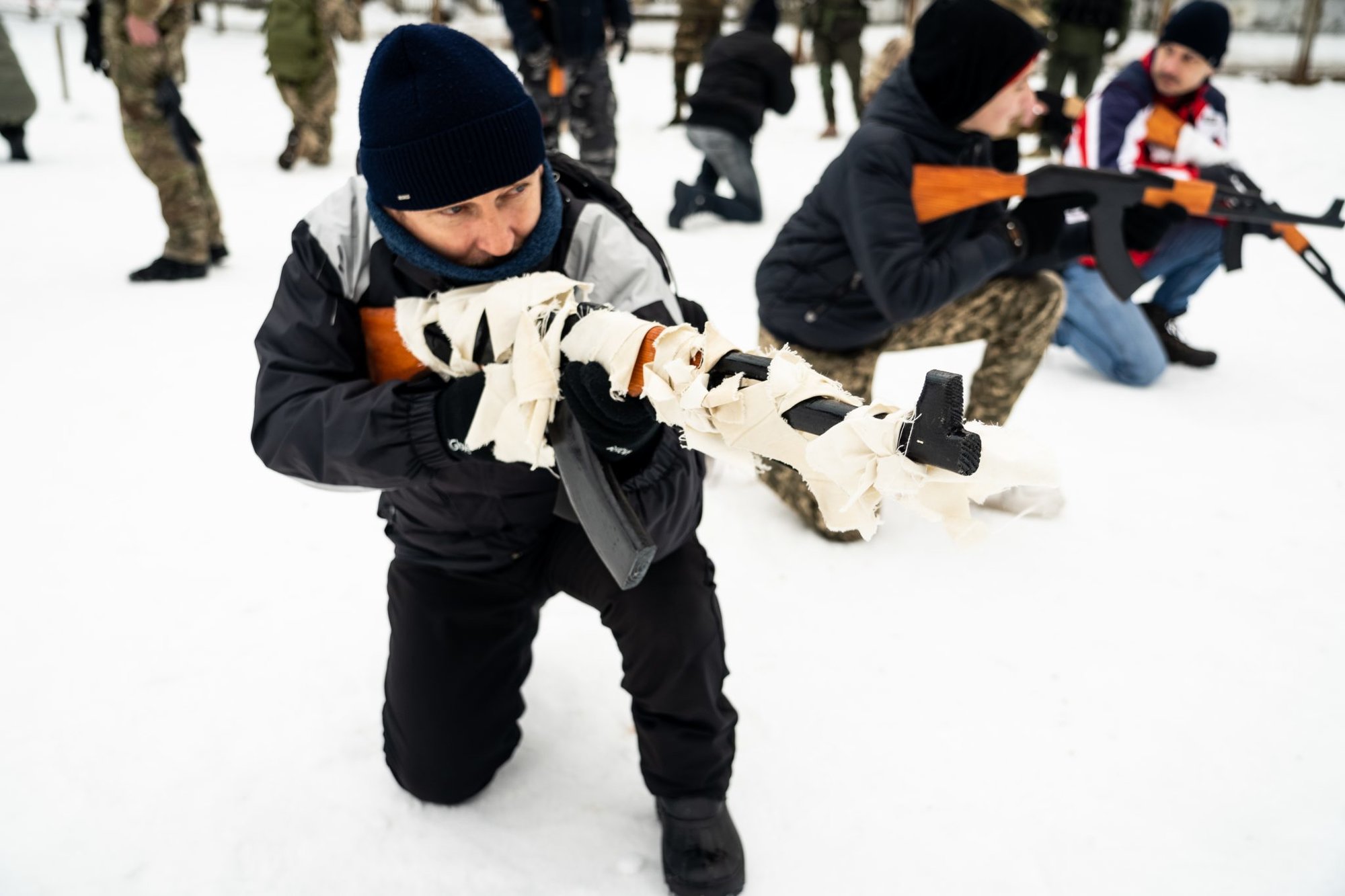
“Looking at the American occupation of Iraq and the theoretical Russian occupation of Ukraine, the two nations have very similar levels of military competency,” Paul says. “I understand what assets the Russian forces would be looking for, and how to deny those assets. If they actually had to come into Kyiv, they would sweep block to block. They would take key avenues of approach and key terrain features.”
“Fighting the Taliban you see the things they did wrong, that they could have done to win against you,” Adam says. “And you see how a conventional force fights, and how the unconventional force could have exploited that, and they didn’t. So I want to take those skills and I want to apply them so that we can exploit the weaknesses of a conventional occupying force.”
In Adam’s estimation, a successful insurgency relies on hit-and-run tactics that maintain pressure on an adversary without ever seeking a decisive battle. The key is to survive and “live to fight another day.”
“The Russians will have artillery support, they’ll have [quick reaction forces]. So when the Ukrainians ambush or raid, they only have maybe five minutes to hit the target, do their damage, and leave,” Adam says.

Even so, Paul added that Kyiv would be a very different urban environment than Iraq’s cities. And a Ukrainian insurgency would be a more formidable fighting force than what America faced in that war.
“Kyiv is a much more sophisticated and modern setting than Baghdad, and the insurgents here, the Ukrainians, would have much more sophisticated equipment and technology,” Paul says. “I think it’s very unlikely that Russians would come into Kyiv; it would just be an incredibly brutal insurgency here.”
About two dozen Ukrainian civilians line up in formation while a Russian-speaking Georgian National Legion soldier explains the day’s training objectives. Through the help of an interpreter, Adam introduces himself and then uses a whiteboard and multicolored markers to explain, in professional detail, the basics of an ambush. He specifically modifies his lesson for the purposes of the irregular fighters he’s teaching.
“The Ranger doctrine for an ambush would be to gather the enemies’ weapons and equipment and blow it up in place,” Adam says. “But you know, from fighting in Afghanistan, we saw how the Taliban and ISIS would take our weapons and try to secure as much gear as possible. So it’s not really about just following the US doctrine that was taught, but to also learn from what the enemy did to us.”
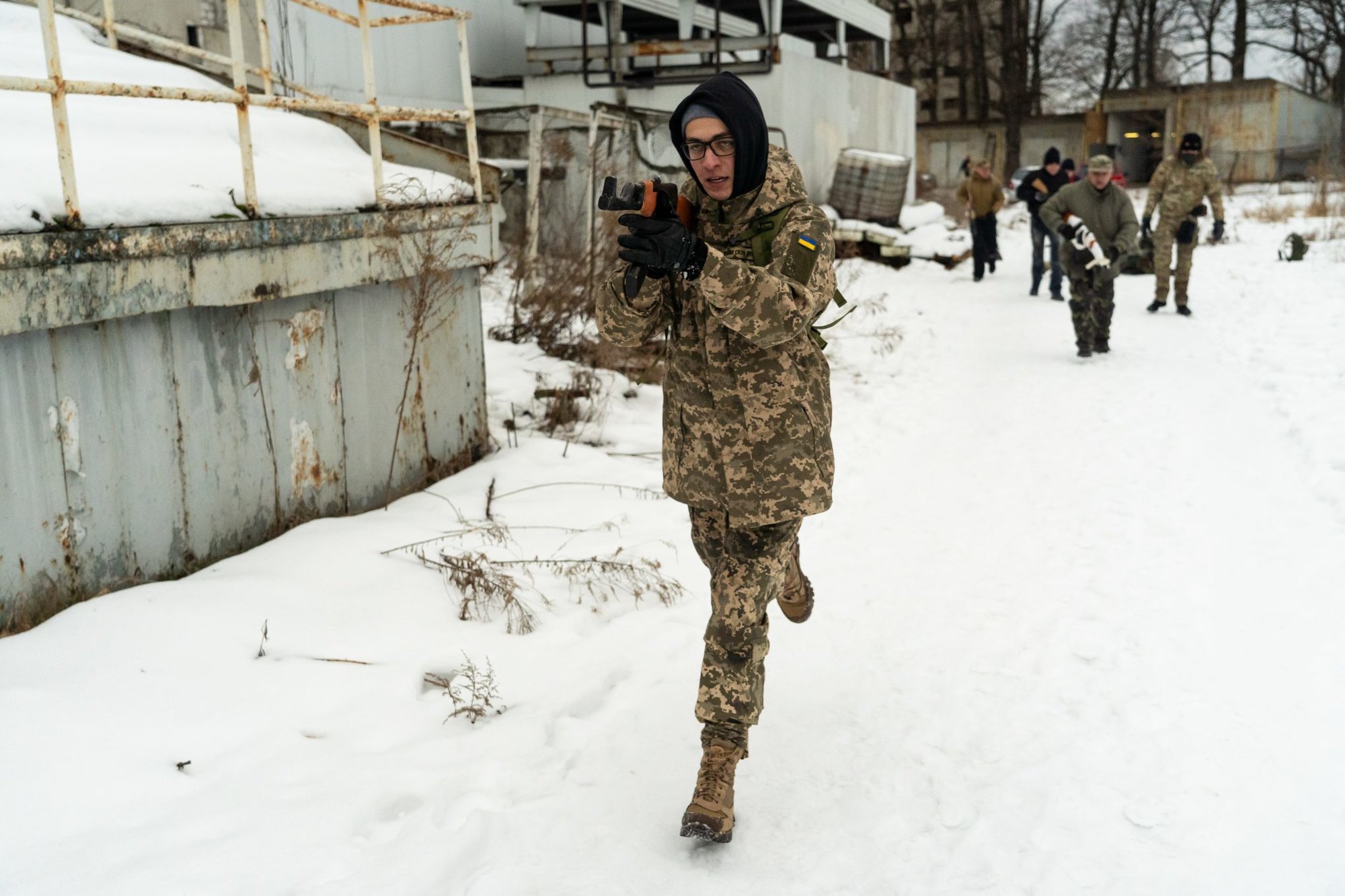
Learning how to set up an ambush is “a good skill to have if you’re fighting a guerrilla war or defending a city,” Paul says. Apart from military action, however, he adds that “general noncompliance” is another way in which Ukrainians could resist a Russian occupation force. Simple acts of resistance — such as not showing up for work — can effectively shut down society and put pressure on a prospective pro-Russian puppet government installed by Moscow in the wake of a major offensive.
“Ukrainians could make it extremely hard for a pro-Russian government to operate here,” Paul says.
Admittedly, something may be lost in translation. And the skill set Adam explains may be a bit beyond the current capabilities of this somewhat ragtag group of citizen soldiers. Even so, the trainees stand in respectful silence and try their best to absorb what they can. When the theoretical discussion is over, Adam then puts the group through multiple trial runs.
The trainees sprint from position to position with the unquestioning commitment of recruits in basic training — even though many are in their 40s or older and past their physical primes. By Adam’s account, they pick up his lessons quickly. Though Adam has spent just two days in Ukraine, the civilians’ commitment to military training makes a powerful impression on the American veteran.
In particular, there is 13-year-old Oleg.
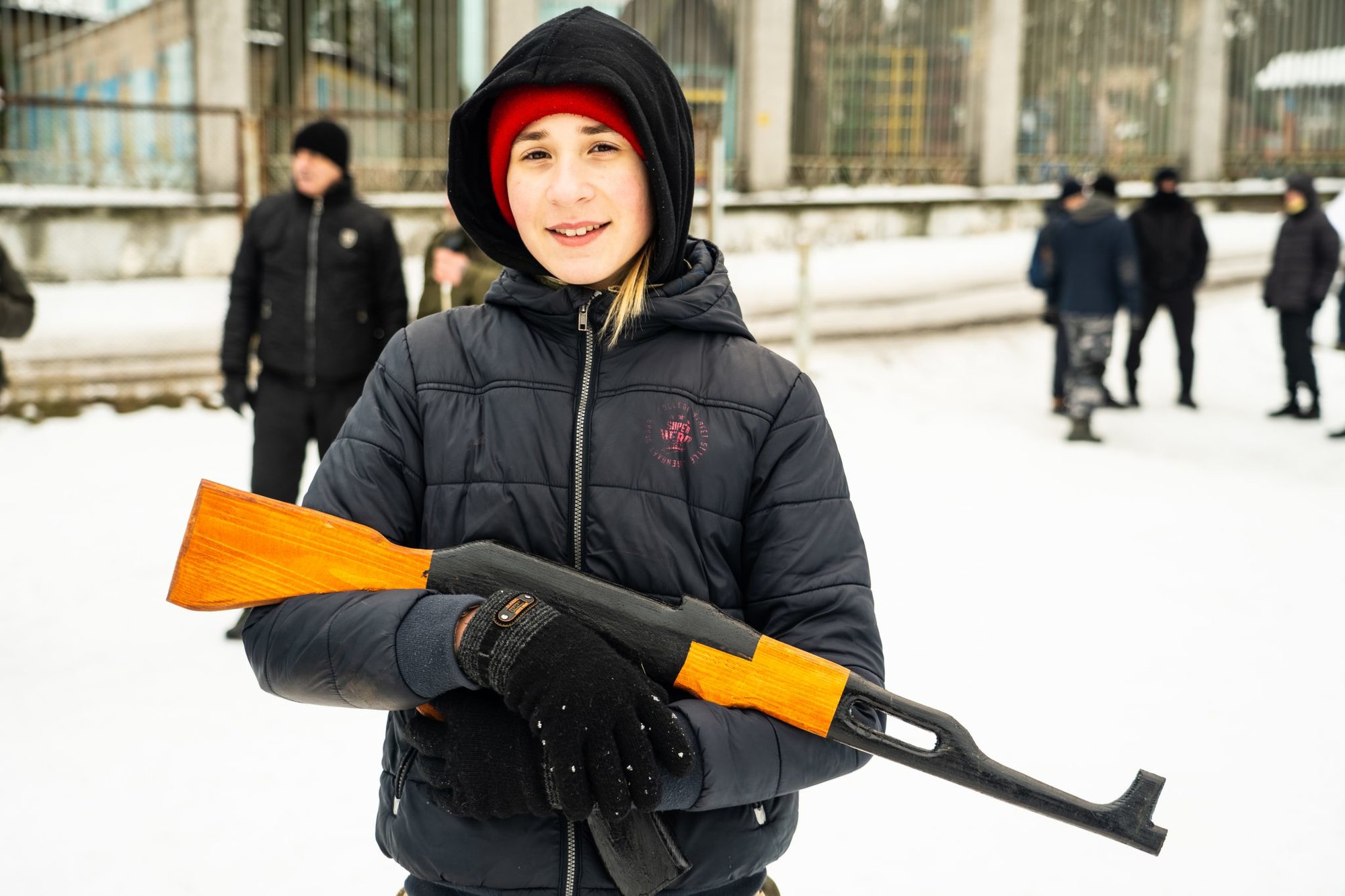
When asked why he volunteered for military training, Oleg replies, “I’m afraid that Russia might invade, and I want to be able to protect my friends.”
Two days later, Adam once again leads a group of Ukrainian citizens through an afternoon of military drills. On this day, they’re at a shooting range outside of Kyiv for a day of target practice with Kalashnikovs. Among the trainees, once again, is 13-year-old Oleg.
The boy’s body armor vest appears oversized on his slight frame. His ballistic helmet is way too big and keeps falling down over his eyes as tries to take aim while shooting from the prone position. He’s clearly nervous; his movements are jerky and unsure. Then Adam kneels beside Oleg and puts a hand on the boy’s shoulder and pulls up his helmet so that he can see and take aim.
Oleg fires a few shots and then stands to fire a few more. As Oleg shoots, Adam keeps a hand on the boy’s shoulder the entire time. When Oleg has finished, Adam nods, pats him on the back, and says, “Good job.”
“It’s inspiring but it’s sad at the same time,” Adam later says of the Ukrainians’ will to fight. “I wish they could just live normal lives. But it can’t be that way. So I’m here to help.”
Read Next:

BRCC and Bad Moon Print Press team up for an exclusive, limited-edition T-shirt design!
BRCC partners with Team Room Design for an exclusive T-shirt release!
Thirty Seconds Out has partnered with BRCC for an exclusive shirt design invoking the God of Winter.
Lucas O'Hara of Grizzly Forge has teamed up with BRCC for a badass, exclusive Shirt Club T-shirt design featuring his most popular knife and tiomahawk.
Coffee or Die sits down with one of the graphic designers behind Black Rifle Coffee's signature look and vibe.
Biden will award the Medal of Honor to a Vietnam War Army helicopter pilot who risked his life to save a reconnaissance team from almost certain death.
Ever wonder how much Jack Mandaville would f*ck sh*t up if he went back in time? The American Revolution didn't even see him coming.
A nearly 200-year-old West Point time capsule that at first appeared to yield little more than dust contains hidden treasure, the US Military Academy said.












